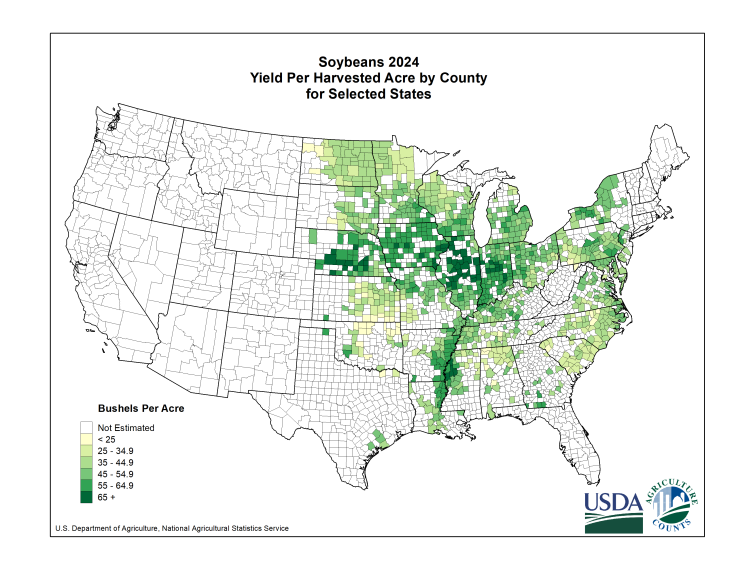Soybean Yield Map of the US


Alex Cartwright
Senior Cartographer & GIS Specialist
Alex Cartwright is a renowned cartographer and geographic information systems specialist with over 15 years of experience in spatial analysis and data...
Geographic Analysis
What This Map Shows
The "Soybean Yield Map of the US" provides a comprehensive visualization of the regions across the United States that exhibit the highest yields for soybean production. Soybeans are a crucial agricultural commodity, playing a significant role not only in the economy but also in global food systems. This map highlights key areas where farmers achieve optimal soybean yields, reflecting various factors such as soil quality, climate, and farming practices.
Deep Dive into Soybean Production
Soybeans, scientifically known as Glycine max, are legumes native to East Asia but have become a staple crop in the United States. In fact, the US is the largest producer of soybeans in the world, contributing nearly 30% of global supply. This crop is integral to numerous industries, serving as a primary source of protein for livestock feed, cooking oil, and even biofuels.
Interestingly, soybean yields can vary significantly from one region to another, influenced by factors such as temperature, precipitation, and soil types. The average yield across the nation hovers around 50 bushels per acre, but in some prime areas, farmers can achieve yields exceeding 70 bushels per acre.
Key states leading in soybean production include Illinois, Iowa, and Indiana, often referred to as the “Corn Belt” due to their fertile soil and favorable climate conditions. In Illinois, for example, the rich, dark soils combined with adequate rainfall during the growing season create an ideal environment for soybean cultivation. According to recent data, Illinois alone accounts for nearly 15% of the nation’s total soybean production.
Moreover, what’s fascinating is the evolving agricultural practices that enhance yield. Precision agriculture, which utilizes technology such as GPS and soil sensors, allows farmers to monitor and manage their fields more effectively, leading to increased productivity. Additionally, crop rotation and the use of genetically modified organisms (GMOs) have also contributed to improved yields and resilience against pests and diseases.
Regional Analysis
When analyzing the map, it becomes apparent that the Midwest region stands out as the powerhouse of soybean production. Illinois consistently ranks at the top, closely followed by Iowa and Indiana. These states not only enjoy favorable climate conditions but also have well-established infrastructures, such as transportation systems, that facilitate the distribution of soybeans.
On the other hand, states like Mississippi and Arkansas, while showing potential, have not reached the same yield levels as their Midwestern counterparts. This disparity can be attributed to several factors, including soil composition and less favorable weather conditions. For instance, while the Delta region is known for its rich alluvial soils, the climate is more humid, which can lead to challenges like disease pressure impacting soybean yields.
Interestingly, the Northern Plains, including states like North Dakota and South Dakota, have also been increasing their soybean production in recent years. As traditional crops like wheat face yield challenges due to climate variability, many farmers are diversifying their crop choices by incorporating soybeans, which are known for their adaptability to cooler temperatures.
Significance and Impact
The significance of understanding soybean yields cannot be overstated. As global demand for soybeans continues to rise, particularly in countries like China, the US's ability to maintain high production levels is crucial for economic stability. Furthermore, soybeans play a key role in sustainable agriculture practices, as they can fix nitrogen in the soil, reducing the need for synthetic fertilizers.
Moreover, as climate change alters growing conditions, it’s essential for farmers and policymakers to adapt strategies that ensure consistent yields. This may include investing in research for drought-resistant soybean varieties or implementing better water management practices. With agriculture being a vital component of the US economy, keeping a keen eye on soybean yields will be essential for ensuring food security and economic resilience in the face of changing environmental conditions.
In conclusion, the "Soybean Yield Map of the US" not only illustrates where high yields occur but also highlights the interconnectedness of agricultural practices, climate, and economic factors that shape this essential industry. As we move forward, understanding these dynamics will be vital for both farmers and consumers alike.
Visualization Details
- Published
- October 12, 2025
- Views
- 52
Comments
Loading comments...